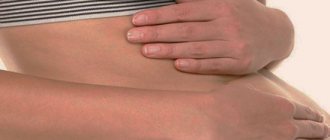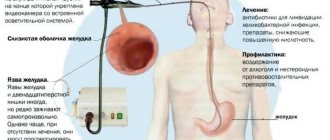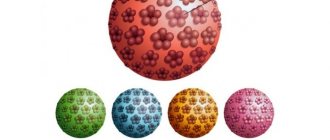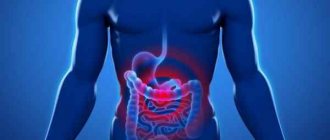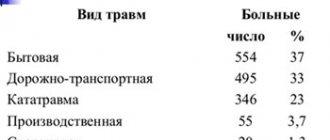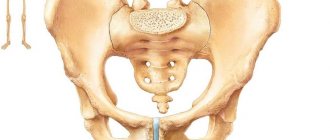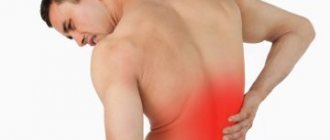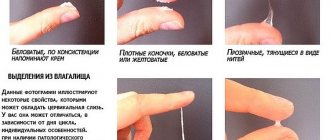Abdominal pain on the left after eating appears with the development of a pathological process in the organs of the digestive tract. Most people prefer to cope with this symptom on their own and eliminate the pain with the help of antacids or enzyme medications.
But medications have only a temporary effect and do not affect the course of the disease, so the disease progresses, becomes chronic and causes various kinds of complications. To avoid the development of the disease, it is necessary to undergo an examination that can determine why pain appears in the left hypochondrium after eating.
Based on the location of the pain, its nature and time of onset, one can assume which organ of the abdominal cavity has ceased to cope with its function. If pain is felt after eating, this indicates a violation of the digestive or evacuation function of the gastrointestinal tract (GIT).
Pain immediately after eating indicates the presence of an inflammatory or degenerative process in the tissues of the stomach, duodenum or pancreas. In addition to pain, other symptoms occur in diseases of the digestive tract, but they are rarely specific, so laboratory and instrumental testing is required to make a diagnosis.
The sooner the cause of pain is determined, the greater the chance of avoiding the disease becoming chronic and the lower the risk of complications. And yet, if the clinical picture is characteristic of a disease, then knowledge of the features of its non-drug treatment will help to avoid attacks of pain and provide functional rest for the inflamed organ.
Accompanying symptoms
Heaviness in the left side under the ribs is not the only sign of a developed disease. As a rule, patients also develop other symptoms indicating the presence of pathology. It is necessary to pay attention to the type and nature of the unpleasant sensations in order to know approximately what kind of illness we are talking about.
Pain comes in the following varieties:
- Visceral. Formed as a result of intestinal dysfunction due to spasms. It is localized mainly in the left side, although sometimes the pain spreads to neighboring areas of the abdomen.
- Peritoneal. The pain reaction is constant and does not go away for a long time. In this case, heaviness appears mainly in the left side under the ribs in front. The pain syndrome is aggravated when performing physical exercises.
- Referred pain is considered a symptom not of diseases of the abdominal organs, but of others - for example, the lungs or heart. Added to this is the difficulty of breathing.
- Acute pain. If a cutting pain suddenly appears in the front of the abdomen, it is necessary to urgently go to a medical facility: in the left side there is a possible rupture of the spleen, on the right there is appendicitis.
- Dull pain indicates a chronic disease. The causes of this symptom are numerous: it can be gastritis, pancreatitis, or ulcer.
Also, many patients complain of aching pain. This sign signals the occurrence of inflammation. If, in addition to pain, the patient experiences vomiting, he suffers from a peptic ulcer.
Types of pain and possible diagnoses
Without a full examination and tests, not a single doctor could determine why a person had pain under his left breast. Because pain in itself is not a definite sign of any disease. The pain can manifest itself in different ways, and even radiate to the arm, collarbone and shoulder blade. If you have pain under your left shoulder blade, chest below, you first need to determine the nature of the pain. It is necessary to distinguish between the types of pain: aching, strong, sharp, stabbing.
Possible reasons
The reasons that provoke heaviness in the left side are different. As a rule, unpleasant sensations are localized in the location of the diseased organ. If pain occurs on the left side under the ribs, there is a possibility of diseases of the liver, stomach, and intestines. Heaviness on the lower right side indicates diseases of the kidneys, ovaries, and bladder.
Let's look at the most common reasons that cause heaviness and pain in the left side:
- Gastritis is an inflammation of the stomach, the symptoms of which appear immediately after eating. In general, the causes of gastritis are associated with poor nutrition, overeating or undereating. In addition, gastritis occurs due to alcohol and tobacco abuse, as well as as a result of the use of certain medications. There are two main forms of gastritis: acute and chronic.
- Ulcer. Signs of the disease appear immediately after eating. Moreover, the disease appears not so much from poor nutrition as from stress and weakened immunity due to chronic pathological processes in the body. Small ulcers form on the mucous membrane of the stomach or duodenum, which increase in size over time. If treatment is not started in time, they can grow so large that internal bleeding occurs. With a stomach ulcer, the pain is localized in the center of the solar plexus under the ribs. In the case of a duodenal ulcer, the pain reaction occurs directly under the ribs.
- Mononucleosis is one of the types of tonsillitis, the causative agent of which is transmitted through blood or saliva. As a result of the pathology, the spleen increases in size, after which pain occurs in the left side. If the spleen enlarges too much, it will rupture. Symptoms of this will be: very severe pain inside the abdomen, blue navel. In this case, the patient needs emergency surgical care.
- Diaphragm hernia. The pathology is typical for older people. The diaphragm is muscle tissue located between the peritoneum and sternum. It has an opening through which the esophagus and stomach are connected. An enlargement of this hole is called a hernia. The patient’s abdomen visually enlarges and seems inflated.
- Often, heaviness in the left side under the ribs in front is observed in pregnant women. This is often due to the attachment of the fetus to the left side of the uterus, although sometimes the symptoms are caused by pathogenic processes (miscarriage, frozen pregnancy). If signs of the disease occur mainly after eating, they are most likely caused by indigestion, which is typical for pregnant women.
- Prostate. This is a purely male disease, which is characterized by a decrease in a man’s sexual activity, as well as severe pain in the groin and lower abdomen. If treatment for the disease is not started, the patient will experience chronic infertility.
- Endometriosis is a disease of the uterus in women that disrupts the menstrual cycle. Moreover, menstruation is very painful.
Acute pain is usually caused by pancreatitis. Moreover, unpleasant symptoms appear in both the left and right sides. The pain is very pronounced and radiates to the back. In addition, the temperature rises, the patient feels nauseous and dizzy. Often, patients with pancreatitis experience heaviness in the left side after eating. The patient is advised to include fats and carbohydrates in his diet.
Strong pain
Severe burning pain under the left breast when moving or coughing can be a sign of pneumonia, pleurisy, angina pectoris and acute pericarditis, which is associated with inflammation of the nerve endings. If the rib hurts under the left breast and there is external pain, then the cause may be irritation of the intercostal nerves as a result of muscle spasm. Most often, this determines the diagnosis of osteochondrosis or intercostal neuralgia.
You should pay special attention to whether the pain radiates to your left arm or under your shoulder blade. If there are such transient unpleasant sensations, then this may portend a myocardial infarction. Severe pain, which appears even with mild shortness of breath, indicates thromboembolism in the lung.
Treatment
Under no circumstances is it recommended to self-medicate. Indeed, often pathologies that cause heaviness in the abdominal area require surgical intervention. Approximately 60% of patients who went to the doctor with heaviness in the left side required emergency assistance from specialists. So, you need to urgently go to the hospital if any symptoms appear.
After the patient arrives at the clinic complaining of heaviness in the left side of the lower abdomen, the doctor begins diagnostic tests to make a diagnosis. An ultrasound of the abdomen and an MRI are performed. A chest X-ray and ECG are also needed to rule out problems with the heart and lungs, which often cause breathing problems.
After the doctor has made a diagnosis, therapy begins. In the case of cancer, the patient requires surgical intervention. Surgery is also necessary for advanced cases of peptic ulcer.
Each disease has its own treatment characteristics:
- In the initial stages of gastritis, a special diet is sufficient for the patient. He must exclude fried and smoked foods and spices from his diet, and in no case should he drink alcoholic beverages. If more serious damage to the mucous membrane occurs, the doctor prescribes special medications. Gastritis should not be left untreated, as this can lead to more serious stomach problems.
- If you have a peptic ulcer, the patient also needs a special diet. You are allowed to eat only boiled and steamed foods. Salt and sugar are consumed to a minimum or completely excluded from the diet. Treatment of ulcers depends on a number of factors: age, the presence of other ailments, allergies to medications. Medicines only eliminate the symptoms of an ulcer, but are not able to cure it completely.
Diagnostics
Only a clinician can determine the causes of distension under the left or right ribs based on the results of a laboratory and instrumental examination of the patient.
Given that the described symptom is often a consequence of problems in the digestive system, you should first of all consult a gastroenterologist.
However, during the diagnostic process you may need help:
- nephrologist;
- gynecologist;
- traumatologist;
- pulmonologist;
- therapist;
- pediatrician
The first diagnostic step includes the following manipulations:
- familiarization with the medical history for possible identification of the provoking disease;
- collection and analysis of life history to confirm or refute the fact of exposure to harmless causes;
- assessment of the condition of mucous membranes and skin;
- palpation and percussion of the abdomen;
- measurement of heart rate, blood pressure and temperature values;
- a detailed survey of the patient to obtain a complete list of the patient’s complaints, to determine the degree of severity and the first time of appearance of the main symptom.
A comprehensive examination of the body in cases where distension appears in the right hypochondrium combines:
- general blood and urine analysis;
- blood biochemistry;
- microscopic examination of feces;
- PCR diagnostics;
- hormonal and immunological studies;
- bacteriological blood culture;
- liver tests;
- abdominal ultrasonography;
- gastroscopy and irrigoscopy;
- ECG and FGDS;
- CT and MRI;
- chest x-ray;
- biopsy.
It should be noted that these are only general diagnostic procedures - additional laboratory and instrumental examinations will be prescribed by the clinician to whom the patient will be seen.
Chest pain: how to distinguish heart pain from other pains
How to distinguish heart pain from others? What examination do you need to undergo? The editors of Vesti talk about all this. Medicine was told by neurologist, candidate of medical sciences, head of the Yusupov hospital hospital Sergei Vladimirovich Petrov.
Sergey Vladimirovich Petrov
Pain is a signal from the body that indicates a problem. There are several organs located in the chest and each can be a source of pain. When a person experiences pain in the chest, it may be due to osteochondrosis, an inflammatory process in the lungs, a disease of the esophagus, but it can also be heart pain.
Typically, any pain leads to a decrease in quality of life, but not all pain is life-threatening. Some types of pain indicate a serious problem in the body. And if you do not respond correctly to this pain, then not only your quality of life may suffer, but you will also suffer enormous harm to your own health, and even death is possible. One of these types of pain is heart pain.
Heart pain (in medicine called angina pectoris or “angina pectoris”) occurs when there is insufficient oxygen supply to the heart muscle. Most often this occurs due to a narrowing of the lumen of the vessel that feeds one or another part of the heart muscle. In most cases, the way the patient describes his pain is sufficient to diagnose angina.
Traumatic injury
It is not difficult to damage the integrity of the spleen - it is protected only by a thin layer of peritoneum. Any strong blow to the left hypochondrium can cause a bruise, crack or rupture of the organ. With a closed injury, this is indicated by symptoms such as:
- sharp pain along the entire side, radiating to the back and collarbone;
- dizziness;
- nausea and vomiting;
- paleness and cold sweat;
- decreased blood pressure;
- rapid pulse;
- noticeable bruising on the left side of the abdomen.
Depending on the severity of the damage, these signs may not appear all at once or all at once. This is why x-rays of the peritoneal organs are required after accidents, falls on the stomach, or rib fractures.

